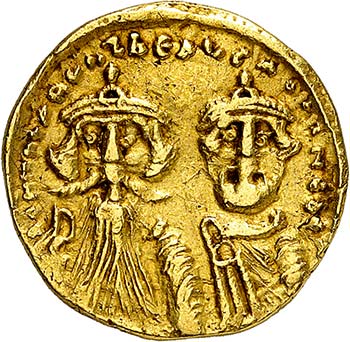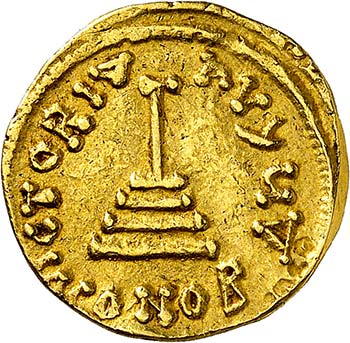- Startseite
- Auction 12
- 158 Umayyad Dynasty - Pseudo-Byzantine coinage, temp. Caliph ...
Los Nr. 158 - Auction 12
Gebote
Beschreibung
Erhaltung: An extraordinary rarity of the early Umayyad coinage. Good very fine.
The Byzantine solidus was the gold coin in universal use throughout the eastern Roman world. After the collapse of Byzantine rule in Syria the need for locally produced gold coinage prompted the caliph Mu’awiya to strike his own gold coinage. Several de-Christianized types (without Christian symbols) were produced, copied from the Byzantine coinage of the Emperors Phocas and Heraclius. They are the earliest gold coinage of Islam and witness the development of an original culture and iconography. On this coin, unique and unpublished with the officina letter A, the Christian crosses have been removed from obverse headdresses and the reverse cross was transformed as a pole. These imitations, are well documented by the late George Miles, curator of Islamic coins in the American Numismatic Society, whose book is still the standard authority on this series. It is likely that the extreme rarity of this coin is a result of having been withdrawn from circulation because it offended both the Byzantines and the Muslims, especially after the creation of the first purely Islamic gold coin, the Dinar in AH 77.
Bitte melden Sie sich an, oder registrieren Sie sich für Ihren persönlichen Zugang.
Für weitere Informationen schreiben Sie uns an auction@ngsa.ch
Auction 12
Kategorien
Auktion: Auction 12
- Antikes Ägypten
- Keltische Münzen
- Griechische Welt
- Münzen der Römischen Republik
- Münzen der Römischen Kaiserzeit
- Byzantinische Münzen
- Zentralasien
- Die islamische Welt
- Renaissance-Medaillen - Sammlung Alain Moatti
- Renaissance-Medaillen - Sammlung APW
- Südafrika
- Albanien
- Deutschland
- Annam/Vietnam
- Armenien
- Österreich / Heiliges Römisches Reich
- Belgien
- Bolivien
- Brasilien
- Bulgarien
- Kambodscha
- Chile
- China
- Kolumbien
- Komoren
- Kroatien
- Kuba
- Dänemark
- Ägypten
- Vereinigte Arabische Emirates
- Ecuador
- Spanien
- Äthiopien
- Frankreich
- French provincial coins
- Französische Kolonialmünzen
- Finnland
- Großbritannien
- Britische Kolonialmünzen
- Griechenland
- Guatemala
- Guinée Labé (Fouta Djalon)
- Haiti
- Hawaii
- Honduras
- Ungarn
- Indien
- Indonesien
- Iran
- Irland
- Italien
- Japan
- Lettland
- Libanon
- Liechtenstein
- Madagaskar
- Marokko
- Mexiko
- Monaco
- Montenegro
- Norwegen
- New Guinea
- Oman
- Niederlande
- Österreichische Nederlands
- Philippinen
- Polen
- Puerto Rico
- Portugal
- Rumänien
- Russland
- Republik San Marino
- Serbien
- Schweden
- Schweiz
- Tschechoslowakei
- Tschechien
- Thailand
- Transsilvanien
- Uruguay
- USA
- Jugoslawien
Auktionstermine
Vorgebote - Ende
17 11 2019 20:00 CET
Saal-Auktion - Anfang
18 11 2019 15:00 CET
Kontakte
Rond-point de Plainpalais 1, Ginevra, Genève, Schweiz
 Cookie-Richtlinie
Cookie-Richtlinie
Diese Website verwendet Cookies , um die Benutzererfahrung zu verbessern und Informationen über die Nutzung der Website zu sammeln. Sie können unsere Cookie-Richtlinie lesen, alle Cookies akzeptieren und fortfahren durch Klicken auf "Akzeptieren" oder Ihre Auswahl anpassen, indem Sie auf "Anpassen" klicken.
Cookie-Richtlinie
Cookies
Damit diese Website ordnungsgemäß funktioniert, installieren wir manchmal kleine Dateien namens " Cookies " auf Ihrem Gerät. Die meisten großen Websites tun dasselbe.
Was sind Cookies?
Ein Cookie ist eine kleine Textdatei, die Websites auf Ihrem Computer oder Mobilgerät speichern, während Sie sie besuchen. Dank Cookies merkt sich die Site Ihre Aktionen und Präferenzen (z. B. Login, Sprache, Schriftgröße und andere Anzeigeeinstellungen), sodass Sie diese nicht erneut eingeben müssen, wenn Sie zur Site zurückkehren oder von einer Seite zur anderen navigieren.
Wie verwenden wir Cookies?
Cookies von Drittanbietern
Google Analytics
Diese Website verwendet Google Analytics, um Informationen über die Nutzung der Website durch die Nutzer zu sammeln. Google Analytics generiert statistische und andere Informationen durch Cookies, die auf den Computern der Benutzer gespeichert werden. Die über unsere Website erzeugten Informationen werden verwendet, um Berichte über die Nutzung von Websites zu erstellen. Diese Informationen werden von Google gespeichert und verwendet. Die Datenschutzerklärung von Google ist unter folgender Adresse abrufbar: https://policies.google.com/privacy .
Es ist nicht erforderlich, Cookies zu aktivieren, damit die Website funktioniert, aber dies verbessert die Navigation. Es ist möglich, Cookies zu löschen oder zu blockieren, aber in diesem Fall können einige Funktionen der Website nicht richtig funktionieren.Die Informationen zu Cookies werden nicht verwendet, um Benutzer zu identifizieren, und die Navigationsdaten stehen immer unter unserer Kontrolle. Diese Cookies werden ausschließlich für die hier beschriebenen Zwecke verwendet.
So kontrollieren und ändern Sie Cookies?
Sie können Ihre Einwilligung jederzeit in der Cookie-Erklärung ändern oder widerrufen unsere Website.
Datenschutzerklärung
Erfahren Sie mehr darüber, wer wir sind, wie Sie uns kontaktieren können und wie wir personenbezogene Daten verarbeiten in unserer Datenschutzrichtlinie .
Die notwendigen Cookies helfen dabei, die Website nutzbar zu machen, indem sie grundlegende Funktionen wie Seitennavigation und Zugriff auf geschützte Bereiche der Website ermöglichen. Ohne diese Cookies kann die Website nicht richtig funktionieren.
| Name | Lieferant | Zweck | Ablauf |
|---|---|---|---|
| cookieConsent | bidinside | Speichert den Cookie-Zustimmungsstatus des Benutzers für die aktuelle Domäne | 6 Monate |
| PHPSESSID | bidinside | Bewahren Sie den Status des Benutzers auf den verschiedenen Seiten der Site auf. | Wenn die Browsersitzung endet |
| f_display | bidinside | Die f_display-Cookies speichern den vom Benutzer gewählten Anzeigemodus auf den Seiten mit Listen | Wenn die Browsersitzung endet |
| f_page | bidinside | Die f_page-Cookies speichern die vom Benutzer angezeigte Seite auf den Seiten, auf denen Listen vorhanden sind | Wenn die Browsersitzung endet |
| f_rec_page | bidinside | Die f_rec_page-Cookies speichern die Anzahl der Elemente, die pro vom Benutzer ausgewählter Seite auf den Seiten angezeigt werden sollen, auf denen Listen vorhanden sind | Wenn die Browsersitzung endet |
| f_order_by | bidinside | Die f_order_by-Cookies speichern die vom Benutzer ausgewählten Sortierparameter auf den Seiten, auf denen Listen vorhanden sind | Wenn die Browsersitzung endet |
| f_order_dir | bidinside | Die Cookies f_order_dir speichern die vom Benutzer gewählte Bestellrichtung auf den Seiten, auf denen Listen vorhanden sind | Wenn die Browsersitzung endet |
| watch_list_show_imgs | bidinside | Das Cookie watch_list_show_imgs speichert die Wahl des Benutzers, die Bilder der Lose auf der Merklistenseite anzuzeigen oder auszublenden | Wenn die Browsersitzung endet |
| selected_voice | bidinside | Das Cookie selected_voice speichert die vom Benutzer ausgewählte Stimme für die in der Live-Auktion vorhandene Sprachsynthese | 1 Monat |
| include_autobids | bidinside | Das Cookie include_autobids speichert die Wahl des Benutzers, seine auto-bid auf der Seite 'Ihre Gebote' anzuzeigen oder auszublenden | 6 Monate |
Analytische Cookies helfen zu verstehen, wie Besucher mit der Website interagieren, indem sie statistische Informationen sammeln und an den Datenverantwortlichen übermitteln.
| Name | Lieferant | Zweck | Ablauf |
|---|---|---|---|
| _ga | Registrieren Sie eine eindeutige ID, die verwendet wird, um statistische Daten darüber zu generieren, wie der Besucher die Website nutzt. | 2 Jahre | |
| _gat_gtag | Wird von Google Analytics verwendet, um die Häufigkeit von Anfragen zu begrenzen | 1 Tag | |
| _gat | Wird von Google Analytics verwendet, um die Häufigkeit von Anfragen zu begrenzen | 1 Tag | |
| _gid | Registrieren Sie eine eindeutige ID, die verwendet wird, um statistische Daten darüber zu generieren, wie der Besucher die Website nutzt. | 1 Tag | |
| __utma | bidinside | Wird verwendet, um Benutzer und Sitzungen zu unterscheiden. Das Cookie wird erstellt, wenn die Javascript-Bibliothek ausgeführt wird und keine vorhandenen __utma-Cookies vorhanden sind. Das Cookie wird jedes Mal aktualisiert, wenn Daten an Google Analytics gesendet werden. | 2 jahre |
| __utmt | bidinside | Wird verwendet, um die Anforderungsrate zu drosseln. | 10 minuten |
| __utmb | bidinside | Wird verwendet, um neue Sitzungen/Besuche zu bestimmen. Das Cookie wird erstellt, wenn die Javascript-Bibliothek ausgeführt wird und keine vorhandenen __utmb-Cookies vorhanden sind. Das Cookie wird jedes Mal aktualisiert, wenn Daten an Google Analytics gesendet werden. | 30 minuten |
| __utmc | bidinside | Wird in ga.js nicht verwendet. Auf Interoperabilität mit urchin.js eingestellt. In der Vergangenheit wurde dieses Cookie in Verbindung mit dem __utmb-Cookie verwendet, um festzustellen, ob sich der Benutzer in einer neuen Sitzung/einem neuen Besuch befand. | Wenn die Browsersitzung endet |
| __utmz | bidinside | Speichert die Zugriffsquelle oder Kampagne, die erklärt, wie der Benutzer auf Ihre Website gelangt ist. Das Cookie wird erstellt, wenn die JavaScript-Bibliothek ausgeführt wird, und wird jedes Mal aktualisiert, wenn Daten an Google Analytics gesendet werden. | 6 monate |
| __utmv | bidinside | Wird verwendet, um benutzerdefinierte variable Daten auf Besucherebene zu speichern. Dieses Cookie wird erstellt, wenn ein Entwickler die Methode _setCustomVar mit einer benutzerdefinierten Variablen auf Besucherebene verwendet. Dieses Cookie wurde auch für die veraltete Methode _setVar verwendet. Das Cookie wird jedes Mal aktualisiert, wenn Daten an Google Analytics gesendet werden. | 2 jahre |
Präferenz- / technische Cookies ermöglichen einer Website, sich an Informationen zu erinnern, die das Verhalten oder die Darstellung der Website beeinflussen, wie z. B. Ihre bevorzugte Sprache oder die Region, in der Sie sich befinden.
Wir verwenden keine Cookies dieser Art.Profiling-Cookies werden für Marketingzwecke verwendet, um Website-Besucher zu überwachen. Die Absicht besteht darin, relevante und ansprechende Anzeigen für den einzelnen Benutzer anzuzeigen.
Wir verwenden keine Cookies dieser Art.Nicht klassifizierte Cookies sind Cookies, die zusammen mit einzelnen Cookie-Anbietern klassifiziert werden.
Wir verwenden keine Cookies dieser Art.





 159
159